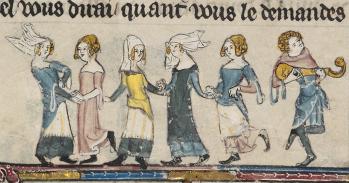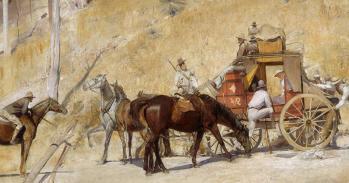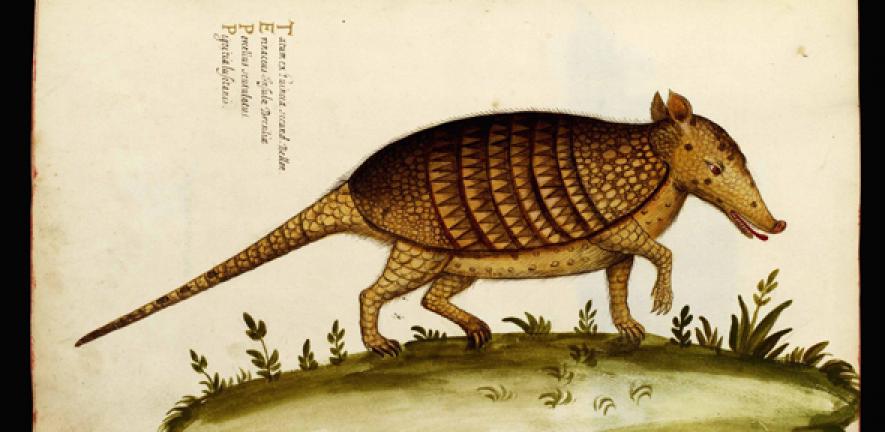
The Cambridge Animal Alphabet series celebrates Cambridge’s connections with animals through literature, art, science and society. Here, X is for Xenarthran. A must-have item for 15th-century collectors of 'curiosities' and a source of fascination for evolutionary biologist Dr Robert Asher.
The Cambridge Animal Alphabet series celebrates Cambridge’s connections with animals through literature, art, science and society. Here, X is for Xenarthran. A must-have item for 15th-century collectors of 'curiosities' and a source of fascination for evolutionary biologist Dr Robert Asher.
It is a most powerful animal that lives in the ground, though also in water and soggy places
Georg Marcgrave
Scroll to the end of the article to listen to the podcast.
Xenarthra is an order of primarily South American mammals that includes sloths, ant-eaters and armadillos. Several are sufficiently endangered to be on the IUCN ‘red list’. In previous millenia, the group was far bigger. It covered many other creatures, now extinct, such as giant ground sloths estimated to have exceeded the size of a male African elephant.
As ‘exotic’ animals, xenarthrans have long fascinated westerners and became a must-have item in ‘cabinets of curiosities’ – collections gathered from a world that was opening up to exploration from the 15th century onwards. In the mid-17th century, the naturalist-physician, Georg Marcgrave, stationed in Dutch Brazil, described the armadillos that he encountered:
"The Tatu or Tatu-peba in Brazilian, Armadillo in Spanish, Encuberto in Portuguese, we Belgians call Armoured-piglet. It is a most powerful animal that lives in the ground, though also in water and soggy places. It is found in various sizes."
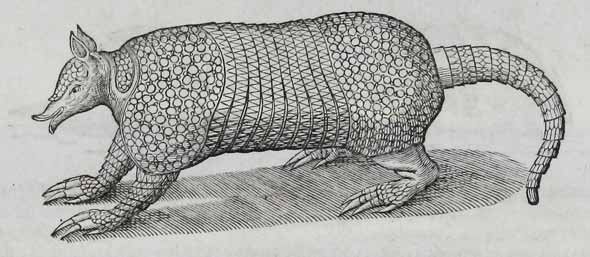
As a consequence of the blossoming of scientific enquiry in the 19th century, many leading zoology museums have examples of xenarthrans in their collections. Cambridge’s Museum of Zoology, for example, has a fine collection of specimens collected on expeditions to South America, from the diminutive Pink Fairy Armadillo (Chlamyphorus truncatus) to the towering giant ground sloth (Megatherium americanum) which became extinct some 10,000 years ago.
The ground sloth is one of a number of relatively recently extinct large sloths, one of which Charles Darwin himself helped discover on the voyage of the Beagle. On September 18, 1832, Darwin noted in his dairy that he had dined on “Ostrich dumpling & Armadillos”. The ‘ostrich’ he ate was, in fact, rhea; the abundant armadillos were a staple diet of the local gauchos.
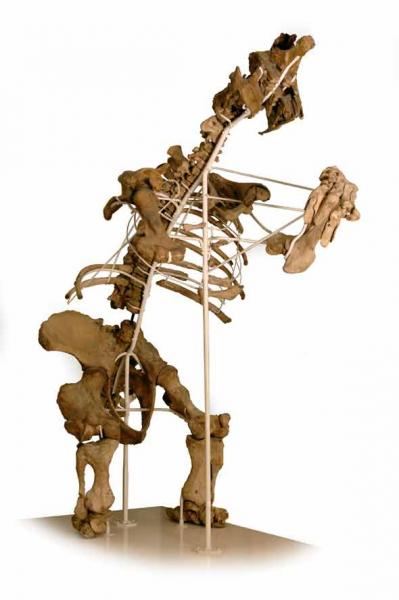
Not long afterwards, Darwin saw for the first time fossils of shells and other animals, embedded in soft sea cliffs, including a specimen of giant ground sloth which was to be named Mylodon darwinii in his honour.
Xenarthans have been a source of fascination to Dr Robert Asher, an evolutionary biologist in the Department of Zoology, ever since he first began studying mammalian diversity as a graduate student some 20 years ago. He’s particularly interested in the evolutionary stories told by the structure of their skeletons – and the ways in which their bones act as clues to their relative position within the tree of life.
Natural history museums in Berlin, Paris and London have in their collections examples of three-toed sloths, including embryos and foetuses. These specimens enabled Dr Robert Asher and his colleague Dr Lionel Hautier (formerly a Cambridge postdoctoral fellow and now at the University of Montpellier) to publish research on an aspect of the anatomy of sloths which sets them apart from almost every other mammal on earth.
The difference lies in the arrangement of vertebrae in sloths’ spinal columns – which can be seen as clues to xenarthrans’ divergent evolutionary pathways over the past few million years.
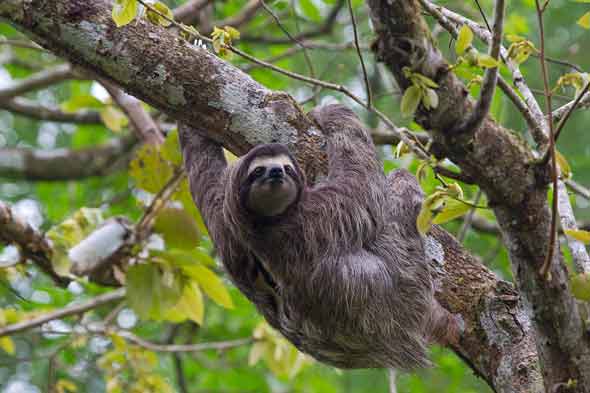
You might think that animals with long necks would have more neck vertebrae than those with short necks. This is certainly true of some birds and reptiles. But almost every placental mammal on earth (some 5,000 species in total) has seven ‘ribless’ vertebrae in the neck – even creatures with long necks such as giraffes. The three-toed sloth deviates from this rule: many of these tree-living creatures have eight, nine or even ten cervical vertebrae.
This remarkable diversity was noticed in the 18th century and scientists continue to tease apart the mechanisms by which mammals deviate from the “rule of seven”. In 2009, Asher and colleagues set out to learn more about this intriguing quirk. Neck vertebrae are known as cervicals and the rib-bearing vertebrae below them are known as thoracics. Thoracic vertebrae have facets which allow articulation with the ribs.
Asher and colleagues looked at patterns of bone formation in mammals as they developed. They found that, in all mammals, the centrum (or middle part) of the first thoracic (number eight, counting down from the skull) turns from cartilage to bone earlier than the centra of the posterior-most cervicals. In sloths, too, the eighth vertebrae begins to develop early – but, in their case, this ribless vertebra is located in the neck and generally considered to be ‘cervical’.
“The ‘extra’ vertebrae in sloths’ necks have the same developmental characteristics as thoracic vertebrae. They are, in effect, ribcage vertebrae, masquerading as neck vertebrae. In sloths, the position of the shoulders, pelvis and ribcage are linked with one another, and compared to their common ancestor shared with other mammals, have shifted down the vertebral column to make the neck longer,” explains Asher.
“Even in sloths, the mammalian ‘rule of seven’ applies to the vertebral centra. The ossification of the centra in a long-necked sloth resembles ossification in other mammals. However, sloths can deviate from the “rule” by shifting the embryonic tissues that give rise to the limb girdles and rib cage relative to the vertebrae, adding what are essentially one or more ribcage vertebrae into the caudal end of their neck. The next question to address is why and how sloths managed this shift.”
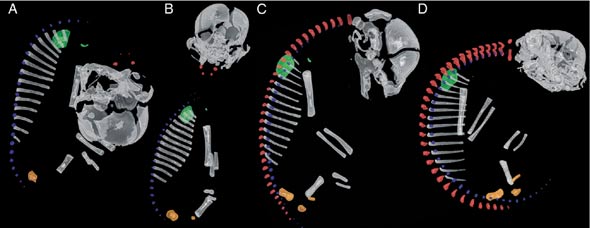
Xenarthrans also pack some intriguing surprises when it comes to teeth. Anteaters have no teeth. Sloths have just one set of teeth to see them through life – as do all but one genus of armadillo. Armadillos in the genus Dasypus (including seven- and nine-banded species) are unlike other armadillos in having two sets of teeth during their lifespan: deciduous (or ‘milk’) teeth and permanent teeth.
Most mammals, including humans, shed their baby teeth while they are growing. Recent research by Asher and colleagues from the University of La Plata, Argentina, into the dentition of Dasypus revealed that its permanent teeth erupt long after the animal reaches its full size. “The equivalent scenario in a human would be losing your milk teeth, and gaining all your permanent ones, once you were fully grown and well into your 20s,” says Asher.
In this regard, Dasypus is similar to most species of endemic African mammals (Afrotheria) – a group of animals that includes elephants, manatees, tenrecs, golden moles and sengis. “Eruption of adult teeth after the attainment of full body size and sexual maturity is not unheard of in other mammals,” says Asher. “Some people reading this won’t yet have erupted their ‘wisdom’ teeth or third molars. But few groups do this as pervasively as Afrotherians and Dasypus.“
With gratitude to PhD candidate Natalie Lawrence (Department of History and Philosophy of Science) for her input on early western encounters with ‘exotic’ animals.
Next in the Cambridge Animal Alphabet: Y is for an animal that is an integral part of high-altitude livelihoods throughout the Himalayas, Tibet and Central Asia.
Have you missed the series so far? Catch up on Medium here.
Inset images: Illustration of an armadillo from Historiae Naturalis Brasilae Tatu by Georg Marcgrave; Skeleton of a giant land sloth (Museum of Zoology); Three-toed sloth - Bradypodidae - Luiaard (Martha de Jong-Lantink); Lateral view of 3D reconstruction of computerized tomography (CT) scans of skeleton in the three-toed sloth Bradypus (Hautier et al).

The text in this work is licensed under a Creative Commons Attribution 4.0 International License. For image use please see separate credits above.



